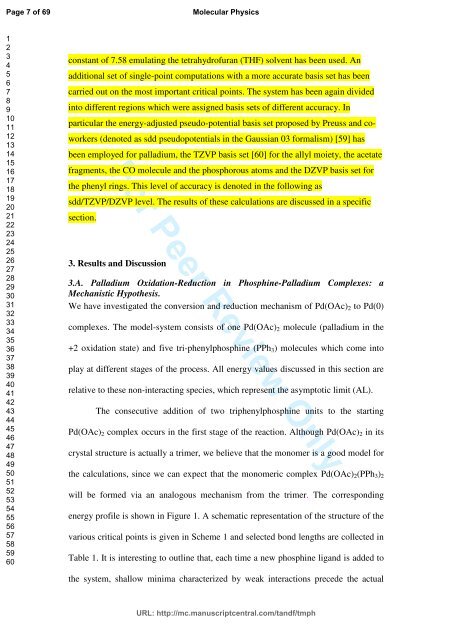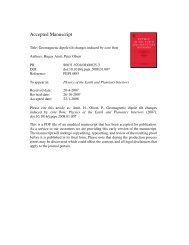For Peer Review Only - TARA
For Peer Review Only - TARA
For Peer Review Only - TARA
Create successful ePaper yourself
Turn your PDF publications into a flip-book with our unique Google optimized e-Paper software.
Page 7 of 69<br />
Molecular Physics<br />
1<br />
2<br />
3<br />
4<br />
5<br />
6<br />
7<br />
8<br />
9<br />
10<br />
11<br />
12<br />
13<br />
14<br />
15<br />
16<br />
17<br />
18<br />
19<br />
20<br />
21<br />
22<br />
23<br />
24<br />
25<br />
26<br />
27<br />
28<br />
29<br />
30<br />
31<br />
32<br />
33<br />
34<br />
35<br />
36<br />
37<br />
38<br />
39<br />
40<br />
41<br />
42<br />
43<br />
44<br />
45<br />
46<br />
47<br />
48<br />
49<br />
50<br />
51<br />
52<br />
53<br />
54<br />
55<br />
56<br />
57<br />
58<br />
59<br />
60<br />
constant of 7.58 emulating the tetrahydrofuran (THF) solvent has been used. An<br />
additional set of single-point computations with a more accurate basis set has been<br />
carried out on the most important critical points. The system has been again divided<br />
into different regions which were assigned basis sets of different accuracy. In<br />
particular the energy-adjusted pseudo-potential basis set proposed by Preuss and coworkers<br />
(denoted as sdd pseudopotentials in the Gaussian 03 formalism) [59] has<br />
been employed for palladium, the TZVP basis set [60] for the allyl moiety, the acetate<br />
<strong>For</strong> <strong>Peer</strong> <strong>Review</strong> <strong>Only</strong><br />
fragments, the CO molecule and the phosphorous atoms and the DZVP basis set for<br />
the phenyl rings. This level of accuracy is denoted in the following as<br />
sdd/TZVP/DZVP level. The results of these calculations are discussed in a specific<br />
section.<br />
3. Results and Discussion<br />
3.A. Palladium Oxidation-Reduction in Phosphine-Palladium Complexes: a<br />
Mechanistic Hypothesis.<br />
We have investigated the conversion and reduction mechanism of Pd(OAc) 2 to Pd(0)<br />
complexes. The model-system consists of one Pd(OAc) 2 molecule (palladium in the<br />
+2 oxidation state) and five tri-phenylphosphine (PPh 3 ) molecules which come into<br />
play at different stages of the process. All energy values discussed in this section are<br />
relative to these non-interacting species, which represent the asymptotic limit (AL).<br />
The consecutive addition of two triphenylphosphine units to the starting<br />
Pd(OAc) 2 complex occurs in the first stage of the reaction. Although Pd(OAc) 2 in its<br />
crystal structure is actually a trimer, we believe that the monomer is a good model for<br />
the calculations, since we can expect that the monomeric complex Pd(OAc) 2 (PPh 3 ) 2<br />
will be formed via an analogous mechanism from the trimer. The corresponding<br />
energy profile is shown in Figure 1. A schematic representation of the structure of the<br />
various critical points is given in Scheme 1 and selected bond lengths are collected in<br />
Table 1. It is interesting to outline that, each time a new phosphine ligand is added to<br />
the system, shallow minima characterized by weak interactions precede the actual<br />
URL: http://mc.manuscriptcentral.com/tandf/tmph
















